refer to exhibit 26-4. what is the productive-efficient level of output?
Economics is all nigh efficiency. Nigh economic issues arise because of scarce resources. Starting from there, we ofttimes take to find ways to use, produce, and distribute those resources in the best possible way (i.due east., efficient). However, depending on the upshot nosotros are looking at, there may be different factors that define whether a situation is considered efficient or not. In other words, there are several different types of economic efficiency. We will look at five of them in more detail beneath: allocative, productive, dynamic, social, and 10-efficiency.
Allocative Efficiency
Allocative efficiency occurs when all goods and services inside an economic system are distributed according to consumer preferences. In this scenario, price always equals the marginal cost of production. The reason for this is that the price consumers are willing to pay for a production or service reflects the marginal utility they get from consuming the product. Hence, the optimal outcome is achieved when the marginal cost (MC) equals marginal benefit (MB). This is illustrated in the graph beneath.
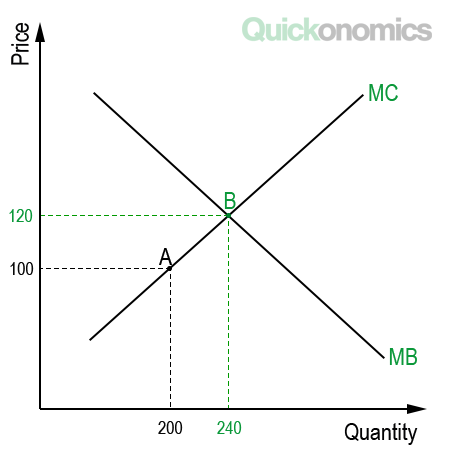
The optimal issue in the illustration is marked past signal B (i.due east., 240 units of output for USD 120). This is at the intersection of the marginal cost bend and the marginal benefit curve. Past dissimilarity, point A does not correspond an allocatively efficient outcome, because the marginal cost of production does non equal marginal do good at this betoken.
Allocative efficiency tin can be found in perfectly competitive markets considering firms in those markets don't accept enough marketplace power to increase prices. To survive, they have to produce what social club values most, at the prices, consumers are willing to pay. By contrast, Monopolies are said to produce allocatively inefficient levels of output, simply because they have enough market power to touch prices and reduce consumer surplus past engaging in price discrimination.
Productive Efficiency
Productive efficiency occurs when the optimal combination of inputs results in the maximum amount of output at minimal costs. That is the instance when firms operate at the lowest point of their average total toll curve (i.eastward., where marginal costs equal average costs). A productively efficient economic system always produces on its product possibility borderland. That means that the economy tin can't produce more of one good or service without reducing the production of another ane.
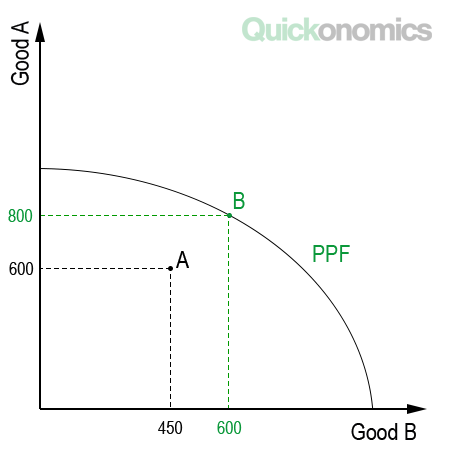
The illustration above shows the production possibility frontier (PPF) for 2 appurtenances (A and B). If an economy produces 600 units of good A and 450 units of good B, it is not working at full capacity. More units of both goods could be produced without reducing the production of the other adept. Thus, we have productive inefficiency. However, if the same economy produces 800 units of good A and 600 units of expert B, it produces on the PPF, which is productively efficient. Please notation that all points on the PPF represent a productively efficient outcome.
Productive efficiency requires all firms to employ the least costly factors of production (e.g., country, labor), the all-time processes, and the almost avant-garde technology available. As well, wastage during production has to be reduced to a minimum, and possible economies of scale have to exist realized. If those conditions are met, it won't be possible for the firms to produce more than goods or services without more inputs.
Keep in mind that productive efficiency does not necessarily take to entail allocative efficiency. For case, if society does not demand 800 units of good A and 600 units of good B, the illustration above does non describe an allocatively efficient upshot fifty-fifty though it is productively efficient.
Dynamic Efficiency
Dynamic efficiency occurs over fourth dimension, every bit innovation and new technologies reduce production costs. In essence, it describes the productive efficiency of an economy (or business firm) over time. We speak of dynamic efficiency when an economic system or business firm manages to shift its boilerplate cost curve (short and long run) down over time. This can be boosted past research and development, investments in human capital letter, or an increment in contest within the market. The graph below illustrates dynamic efficiency.
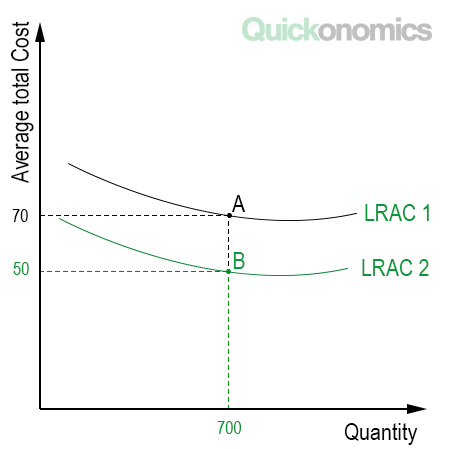
As we can see, the first long-run average cost curve (LRAC i) lies above the second long-run average cost curve (LRAC 2). In many cases, this is what happens over time, as innovation helps to improve products and processes and thus reduce costs. Lower average costs allow firms to sell at a lower toll, which is why indicate A and the entire LRAC one shifts downwardly to point B (and LRAC 2) over fourth dimension.
An economic system with a high dynamic efficiency generally offers more choices of high-quality goods for consumers. This is because invention and innovation not only result in amend processes and lower cost just likewise higher quality goods and services for consumers.
Social Efficiency
Social Efficiency occurs when goods and services are optimally distributed within an economy, as well taking externalities into account. This is the case when the marginal social price of production equals social benefit. This relationship tin be illustrated as follows.
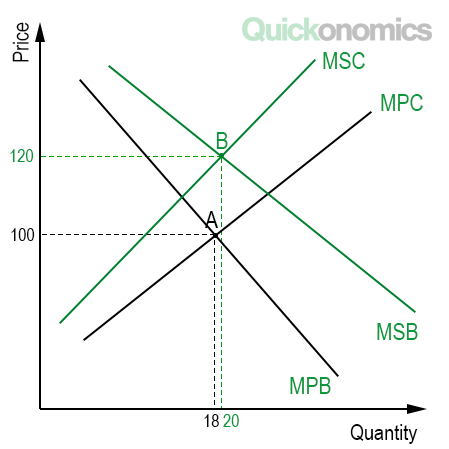
The graph shows ii sets of curves. The intersection of the marginal individual price curve (MPC) and the marginal individual benefit curve (MPB) represents an allocatively efficient outcome (point A). However, if we take externalities into account as well, nosotros accept to wait at the intersection of the marginal social price bend (MSC) and the marginal social benefit curve (MSB) instead. Hence, the socially efficient result is not reached at point A (18 units for USD 100) merely shifts up to point B (20 units for USD 120).
In a socially efficient economy, overall social welfare is maximized. Nonetheless, in well-nigh cases, this requires some form of taxation. In a free marketplace, both consumers and producers don't take externalities into account. Every bit a result, taxes (or subsidies) are required to internalize the externalities and reach a socially efficient outcome (see also Positive and Negative Externalities).
X-efficiency
X-efficiency occurs when a firm has an incentive to produce maximum output with a given amount of input. Hence, information technology is quite similar to productive efficiency. The chief difference between the two is that Ten-efficiency depends on management incentives, whereas productive efficiency depends on processes and technology.
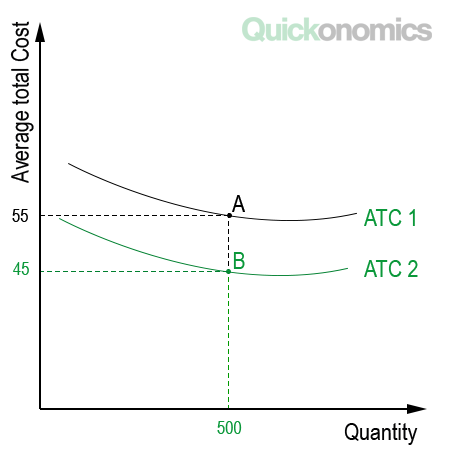
The illustration higher up shows an inefficient average total price bend (ATC 1) and an efficient total cost curve (ATC two) of a firm. This looks quite similar to the illustration of dynamic efficiency. However, in this case, the shift from point A to indicate B does not depend on innovation but but on management incentives. That means the firm can shift its average total costs to ATC 2 from the showtime. Withal, it does not accept any incentives to do so.
We are nigh likely to run into 10-efficiency in highly competitive markets. In those situations, the management has to produce every bit much output as possible (at the lowest possible cost) to remain competitive. By contrast, in a monopoly, we will usually run across a loss of X-efficiency, because the monopolist tin can increment profits by non maximizing output.
In a Nutshell
Near economical problems arise because of scarce resource. Hence, it is disquisitional to use, produce, and efficiently distribute those resources. There are several different types of economic efficiency. The v almost relevant ones are allocative, productive, dynamic, social, and X-efficiency. Allocative efficiency occurs when goods and services are distributed according to consumer preferences. Productive efficiency is a situation where the optimal combination of inputs results in the maximum amount of output. Dynamic efficiency occurs over fourth dimension, every bit innovation reduces production costs. Social Efficiency happens when goods and services are optimally distributed, too taking externalities into business relationship. And final just not to the lowest degree, Ten-efficiency occurs when a firm has an incentive to produce maximum output with a given amount of input.
Source: https://quickonomics.com/five-types-of-economic-efficiency/
0 Response to "refer to exhibit 26-4. what is the productive-efficient level of output?"
إرسال تعليق